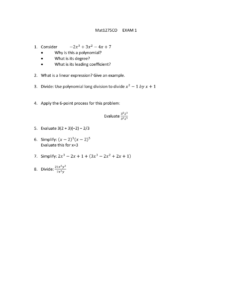A textbook reference is in our Blackboard section: Course Materials / Textbooks
The FINAL EXAM will be Wednesday, May 22.
We have available here the review problems for the final exam. Each student is required to select one of these problems that you will present to the class. The sign up list is on a Google Sheets document:
https://docs.google.com/spreadsheets/d/144IyHZ8n0pZB5u8-74fxX8vGOfILNjEXCAG-_vSNBQ8/edit?usp=sharing
The exam will cover the topics of Circles, Parabolas and Lines
Remember that the circle is defined by its CENTER and RADIUS
Remember that the important characteristics of a Parabola are: VERTEX, LINE OF SYMMETRY, X-Intercepts (“Roots”) and Y-Intercept
The Parabola has the two forms
General Form:
Standard Form
The x-coordinate of the vertex is
To get the y-coordinate of the vertex, put the x-value into
and evaluate it.
The circle has the two forms
General Form:
Standard Form
The Center is at the point (h,k) and the radius = r.
Review these for the exam:
WebWork
Graphs-Graphs of Quadratic Equations. (Problems 1-4)
Graphs-Intro to Conics (Problems 1 and 12)
ShiftingParabolas (Understand all of these)
Graphs-Equation of a Line (Problems 4 and 6)
REMEMBER the 6-point process.
Here are practice problems for the exam:
Zero Product Rule
Solve
Radical Equations
Solve
Quadratic Equations
Rational Equations
Roots
Give a polynomial of degree 4 with roots 2,3,−1 and 0. You can keep it in factored form.
6-point process:
Apply the 6-point discussion to any of the above problems.
Here are practice problems for the exam:
Radical Expressions
Solve
Evaluate
Simplify
Complex Numbers
Simplify
Multiply
Evaluate
Complex Fractions
Apply the 6-point process to the complex fraction below. Then actually simplify it according to your “strategy”
Simplify
These topics will be covered. Most problems will be taken from the Workbook
Order of operations
6-point analysis
About Polynomials
Linear Expressions
Degree of Polynomials
Add and Multiply Polynomials
Divide Polynomials
Factor Polynomials
Citytech has declared that classes will be online because of the expected weather.
Zoom link is: https://us02web.zoom.us/j/3830146922
If you have difficulty connecting, then send me an email or a text message.
Prof. Victor Sirelson
Each group will have a meeting with the Professor during the next 2 weeks.
Each student should have 1 question prepared to ask.
Group 2: Tuesday, February 6 10:30 am – Room N825
Group 1 & Group 3: Wednesday, February 7 10:00 am – Room N825
Group 4: Wednesday, February 7 10:30 am – Room N825
Group 5: Tuesday, February 13 10:00 am – Room N825
Group 6: Tuesday, February 13 10:30 am – Room N825
Group 7: Wednesday, February 14 10:00 am – Room N825
Groups 8 & 9: Wednesday, February 14 10:30 am – Room N825
Professor’s Daily Notes in Class
For now, these are posted on our Blackboard site in the section “Class Notes”
As we discussed in class today, we are using a 6-point system to approach problems. Do a 6-point analysis for the question
“How can I do well in this class?”
Prepare this tonight (Monday) and in Tuesday’s class discuss this with your group. Prepare a single result and post it in your Group Post.
Please take some time to explore this OpenLab course site. Use the menu to explore the course information, activities, and help. As the course progresses, you will be adding your own work to the Student Work section.
Join this Course
Login to your OpenLab account and follow these instructions to join this course.
If you’re new to the OpenLab, follow these instructions to create an account and then join the course.
Remember that your username and display name can be pseudonyms, rather than your real name. Your avatar does not need to be a picture of your face–just something that identifies you on the OpenLab.
Questions
If you have any questions, reach out via email or in Office Hours. If you need help with the OpenLab, you can consult OpenLab Help or contact the OpenLab Community Team.
Class Info
- Date: January 29, 2024
To-Do
Bring a notebook, pen or pencil and be prepared to take good notes during the class.
Topic
Everyone is assigned to a group with 3 or 4 other students.
Group 1
Mohamed Abdelrahim
Taino Juan Bravo I
Mathew Green
Jaylin Logan
Group 2
Danny Acero
Halley Engelique Brito
Tyron Leroy Henry
Merlin Lora
Group 3
Arafat Arefin Adi
Jahdiel Brown
Milly Herrera-Cortes
Navindra Mangra
Group 4
Durant Joshua Aitken
Brendan Sontonax Buissereth
Omarie Jaquan Hill
Darven K Pierre I
Group 5
Fayzah Hussein Alkatabi
Natalia Magdalena Cedeno
Jun Huang
Kyle Nikhail Sinanan
Group 6
Kristal Alvarez
Sai Ceesay
Shaquille Antonio James
Kevin Torres
Group 7
Jahnol Tyreek Arrington I
Kiaya T Celestine
Kastasia Kellman
Jalen Vann
Group 8
Marjona Ashurkulova
Britney A Cordova
Israt Korno
Holly P Vigo
Group 9
Brian Bautista
Yvelanda Delva
Sherece M Loather
Objectives
We will introduce the 6-point approach that will be used in this class.
The problem-solving approach we use in this manuscript is based on the 6-point process developed by Professors Rojas and Benakli 1 .
- Context: What is the problem about?
- Observations: List as many observations as possible (at least three). Include key words and symbols.
- Questions: Write down (at least three) questions you can ask about the problem. Be sure to include any questions you have relating to the observations you have made.
- Strategies: Write down the plan or action strategy.
- Concepts: Write down concepts needed to understand and solve the problem.
- Conclusions: Use complete sentences to express the conclusion.
Activities
Think carefully about these 6 points. Apply them to a problem that interests you. If you like, consider this: “How can I succeed in this class?”






Recent Comments